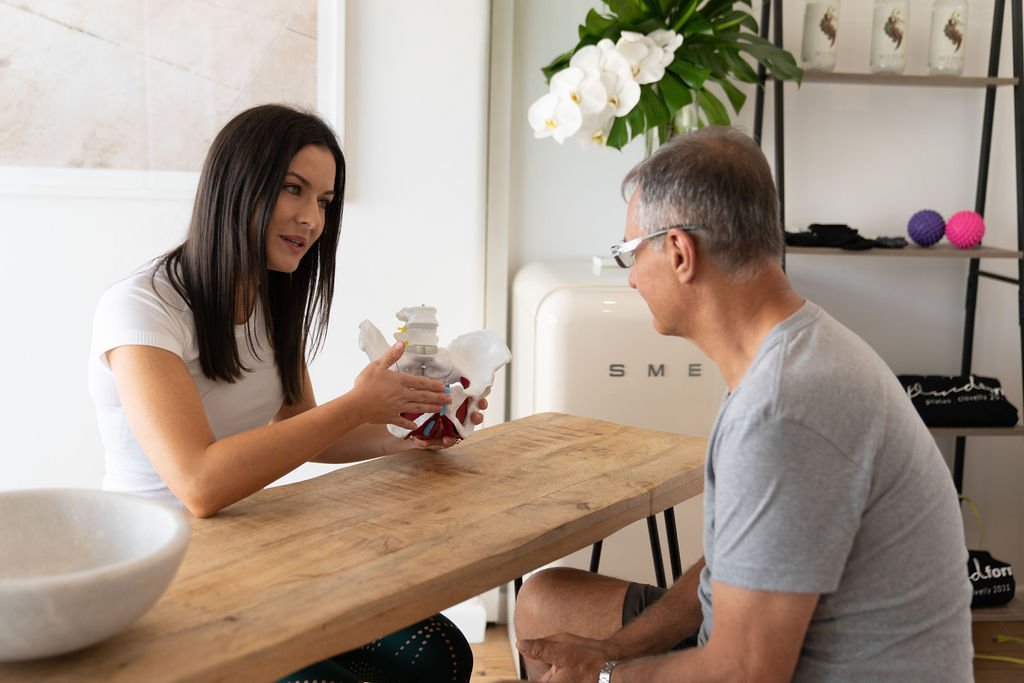BLADDER DYSFUNCTION

Bladder Dysfunction
In order to understand bladder dysfunction, we first need to understand normal bladder function.
Normal bladder function is defined as:
Daytime frequency – 5-7 times
Night time frequency – 0-1 times, 1-2 times as you age
Urge - When you go to the toilet to pass urine you should feel the urge to go but should be able to override it if you need to, this urge will increase as your bladder fills gradually
Voiding (passing urine) – the flow should start quickly and strongly once you are on the toilet. It should then gradually taper off, with no drips once you have finished at the toilet
These norms are based off a regular fluid intake, if you drink a large volume of fluid throughout the day these may be different.
If you feel your bladder symptoms fall outside these norms, you may have bladder dysfunction.
Symptoms of bladder dysfunction are often categorised as the following:
Stress Urinary Incontinence
Urge Urinary Incontinence/Overactive Bladder
Voiding Dysfunctions
Bladder Pain Syndrome
Underactive Bladder
Nocturia (waking frequently overnight to go to the toilet)
The Pelvic Studio is a pelvic floor physiotherapy clinic, and our team is expertly trained to assist you with your bladder dysfunction. Research shows that pelvic physiotherapy can improve bladder frequency, urgency and urge urinary incontinence.
During your assessment, your physiotherapist will complete a thorough subjective and objective assessment, likely including a bladder diary and use of real time ultrasound, to gather information on what could be contributing to your bladder dysfunction.
Treatment may consist of education, bladder retraining, urge deferral techniques, pelvic floor muscle training, voiding techniques and bowel management, as well as referral to relevant specialists if required.
more information

Physiotherapy treatment for Bladder Dysfunction:
During your physiotherapy assessment we will ask you specific questions about your bladder habits, fluid in-take, bowels habits and pelvic health.
It is ideal for you to complete a two-day bladder diary prior to attending your initial appointment. However, if this has not been done we will provide you with a bladder diary and ask you to complete and return it at your next appointment.
At your initial appointment it is ideal to arrive with a comfortably full bladder so that we can perform a bladder scan with the ultrasound machine. This scan is to ensure you are emptying your bladder correctly.
With your consent, an internal examination is performed to assess your pelvic floor muscles. This internal assessment is to ensure you are contracting and relaxing your pelvic floor correctly. Research shows that 60% of those assigned female at birth incorrectly contract their pelvic floor when verbally cued. An internal examination is the best way to examine these muscles properly. However, the pelvic floor can also be assessed using the ultrasound machine, with the probe placed over the lower tummy.
Your pelvic physiotherapist will discuss these two options with you to determine your preferred method of assessment. Once your pelvic floor muscles have been assessed a tailored pelvic floor program can be prescribed.
**Physiotherapy may also include the following **
Assessment and treatment of contributing factors and potential drivers to your bladder symptoms.
Education on normal and abnormal bladder and pelvic floor function.
Bladder calming (urge deferral strategies).
Bladder training (timed-voiding, spacing out how often you empty).
Liaising with Doctors regarding appropriate medical management
OVERACTIVE BLADDER
What is overactive bladder?
Overactive Bladder (OAB) describes symptoms of increased bladder urgency and frequency. Bladder urgency is the sudden and overwhelming desire to pass urine.
Increased bladder frequency refers to passing urine more frequency than every 2 hours during the day, and more than once at night.
Normal bladder frequency ranges from every 2-4 hours during the day, which is about 5-7 times a day.
OAB can be associated with a fear of bladder leakage (OAB-dry) or actual bladder leakage (OAB-wet).
How common is overactive bladder?
Bladder urgency and frequency affects nearly 1 in 2 Australian people assigned female at birth (40%) and 1 in 4 people assigned male at birth (25%).
This sudden and compelling urge to empty your bladder can be triggered by arriving home (key in door), running water, washing hands, swimming, cold weather, change of position, exercise, or for no reason at all.
Can physiotherapy help Overactive Bladder?
Pelvic Physiotherapy is recommended as the first treatment you should try. Research shows that pelvic physiotherapy can resolve symptoms in up to 50% of people with frequency, urgency and urge urinary incontinence
UNDERACTIVE BLADDER
What is underactive bladder (UAB)?
UAB refers to a ‘floppy’ bladder with reduced sensation. In other words, your bladder doesn’t tell you when it’s filling up or when it’s full.
Patients with underactive bladder often say they check the time and realise “Whoops I haven’t been for a wee for hours and hours, I better go!”.
When they finally take themselves to the toilet they can be there for a while. This can be because their bladder is so full it takes a long time to empty. Often their urine flow can be really slow. This is because the bladder is too ‘floppy’ and isn’t contracting like it should to squeeze the urine out.
Patients with UAB can also report extreme bladder urgency that hits them out of nowhere. This may indicate that your bladder isn’t telling you when it’s filling up, but only tells you when it’s really full.
Symptoms of underactive bladder can include
No/minimal desire to empty your bladder even though it’s full.
Emptying your bladder infrequently (>4hrs between voids, with minimal urge)
Emptying large bladder volumes (>500-600mls).
Difficulty emptying your bladder.
Delay to start the flow.
Stop/starty flow.
Weak stream that takes a long time to empty.
A feeling that you haven’t completely emptied your bladder properly.
Severe bladder leakage, with or without warning.
What causes underactive bladder?
Underactive bladder can have various causes, including:
Pelvic surgery (including caesarean sections and laparoscopy)
Post spinal block or epidural
Bladder outlet obstruction (due to a large prolapse, an enlarged prostate or pelvic floor overactivity)
Neurological diseases (Parkinson’s Disease, Multiple Sclerosis)
Spinal cord, cauda equina and peripheral nerve damage
Diabetes
Medication induced
Urinary tract infections
Increasing age can cause a weakening of the bladder muscle
When should I get help?
Underactive bladder is a serious condition and it is important it is addressed sooner rather than later. If you suffer from UAB symptoms consult with your general practitioner as well as your pelvic physiotherapist. Your pelvic physiotherapist/GP will determine if a specialist review is required.
URGE URINARY INCONTINENCE
What is Urinary Urge Incontinence (UUI)?
Urge Urinary Incontinence is the involuntary loss of urine that occurs with bladder urgency. As the bladder fills, it stretches like a balloon, to make room for your urine. When half full, the bladder sends a signal to the brain that you need to go to the toilet. A healthy bladder can old up to 600mLs of urine, and can defer the urge to go until it is a convenient time to go to the toilet. People with UUI often experience an intense urge to urinate even when the bladder isn't full.
What causes UUI?
UUI often becomes more common as we age, and can often be linked with other health issues such a stroke, Parkinson's Disease and Multiple Sclerosis. Symptoms may be worsened by bladder irritants such as coffee, tea, soft drink and alcohol.
How can physiotherapy help ?
Your physiotherapist will provide you with a number of bladder retraining strategies that aim in improving bladder control. Having a well functioning pelvic floor will also help reduced urgency, and hold urine until you're ready to empty.
STRESS URINARY INCONTINENCE
What is Stress Urinary Incontinence (SUI)?
Stress Urinary Incontinence is the involuntary loss of urine, during an acitivty, caused by an increase in pressure on the bladder. In mild cases of SUI this may be a loss of urine when you caugh, laugh, sneeze, jump, run etc. In moderate to severe cases of SUI, you may use urine with less forceful activities such as standing, bending, walking.
How common is SUI?
SUI affects up to 1 in 3 people assigned female at birth.
10% of those who have not had children will experience leakage especially during exercise
Pregnant people are 32% more likely to experience SUI
It is more common in those who have been through menopause, are over the age of 65, are overweight, smoke or have a chronic cough.
SUI in those assigned male at birth is often seen in patients post radiacal prostatectomy
How cam physiotherapy help?
Tailored pelvic floor muscle and bladder retraining has proven highly effective in improving the symptoms of SUI. In fact, up to 75% show improvement with pelvic floor physiotherapy input.






